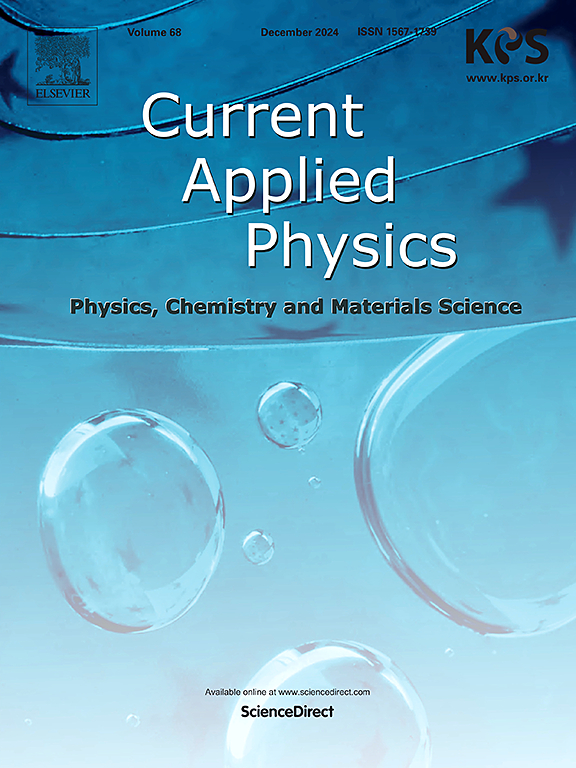Design and application of multi-absorption and highly sensitive monolayer graphene microstructure absorption devices located at terahertz frequencies
IF 3.1
4区 物理与天体物理
Q3 MATERIALS SCIENCE, MULTIDISCIPLINARY
引用次数: 0
Abstract
A graphene absorber has been designed in this message that is based on surface plasmon resonance (SPR). The absorber exhibits four perfect absorption peaks within the target frequency band, featuring an innovative structure with excellent tunability and incident-angle insensitivity. The absorber features a triple-layered framework, with a gold (Au) substrate as the bottom layer, a silica (SiO2) layer serving as the medium layer in the middle, and a graphene layer in a “#” symbol shape at the top. The absorber has a simple structure and is easy to fabricate. We then analyzed four variant that the absorber displays peak absorption efficiencies of 99.99 %, 99.32 %, 99.71 %, and 99.99 % when the frequencies are 7.5005 THz, 9.0920 THz, 10.1181 THz, and 11.3193 THz, respectively, all exceeding 99 %, demonstrating excellent absorption performance. Additionally, we set up four electric field monitors to plot the electric field energy distribution maps for the four absorption peaks. We then analyzed four variant structures derived from the original design, comparing the number of absorption peaks, absorption rates, and sensitivity, and concluded that the model structure proposed in this study is optimal. After changing Fermi degree and time of relaxation, adjustment of the waves can be realized. The absorber demonstrates insensitivity to the angle as the incidence angle is changed from 0° to 60°. Furthermore, with the change of environmental refractive index, the maximum sensitivity among peaks can reach 3586 THz/RIU, showcasing high sensitivity. Finally, we calculated the figure of merit (FOM) and quality factor (Q) values for our model, which we compared with those of other absorbers, concluding that our absorber performs exceptionally well in terms of FOM and Q values. Given these advantages, the absorber designed in this paper can be used in fields of sensors etc.

太赫兹多吸收高灵敏度单层石墨烯微结构吸收器件的设计与应用
本文设计了一种基于表面等离子体共振(SPR)的石墨烯吸收体。该吸收器在目标频段内具有四个完美的吸收峰,具有创新的结构,具有良好的可调性和入射角不敏感性。该吸收器采用三层结构,底层为金(Au)衬底,中间为二氧化硅(SiO2)层作为中间层,顶部为“#”符号形状的石墨烯层。该吸波器结构简单,易于制造。在7.5005 THz、9.0920 THz、10.1181 THz和11.3193 THz频段,吸收效率分别达到99.99%、99.32%、99.71%和99.99%,均超过99%,表现出优异的吸收性能。此外,我们设置了四个电场监测仪,绘制了四个吸收峰的电场能量分布图。然后,我们分析了从原始设计衍生出的四种不同结构,比较了吸收峰的数量、吸收率和灵敏度,得出了本研究中提出的模型结构是最优的。通过改变费米度和弛豫时间,可以实现对引力波的调节。当入射角从0°变化到60°时,吸收器对角度不敏感。随着环境折射率的变化,峰间最大灵敏度可达3586 THz/RIU,具有较高的灵敏度。最后,我们为我们的模型计算了性能值(FOM)和质量因子(Q)值,并将其与其他吸收器进行了比较,得出结论,我们的吸收器在FOM和Q值方面表现得非常好。鉴于这些优点,本文设计的吸波器可用于传感器等领域。
本文章由计算机程序翻译,如有差异,请以英文原文为准。
求助全文
约1分钟内获得全文
求助全文
来源期刊

Current Applied Physics
物理-材料科学:综合
CiteScore
4.80
自引率
0.00%
发文量
213
审稿时长
33 days
期刊介绍:
Current Applied Physics (Curr. Appl. Phys.) is a monthly published international journal covering all the fields of applied science investigating the physics of the advanced materials for future applications.
Other areas covered: Experimental and theoretical aspects of advanced materials and devices dealing with synthesis or structural chemistry, physical and electronic properties, photonics, engineering applications, and uniquely pertinent measurement or analytical techniques.
Current Applied Physics, published since 2001, covers physics, chemistry and materials science, including bio-materials, with their engineering aspects. It is a truly interdisciplinary journal opening a forum for scientists of all related fields, a unique point of the journal discriminating it from other worldwide and/or Pacific Rim applied physics journals.
Regular research papers, letters and review articles with contents meeting the scope of the journal will be considered for publication after peer review.
The Journal is owned by the Korean Physical Society.
 求助内容:
求助内容: 应助结果提醒方式:
应助结果提醒方式:


